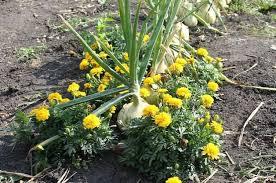Companion planting might sound like a fancy technique, but it’s actually one of the simplest and most natural ways to grow a thriving garden. When I first got into gardening, I didn’t give much thought to what plants went where—I just planted what I liked. But as time passed, I started noticing that some plants just didn’t perform well next to others, while a few pairs thrived together. That’s when I discovered the concept of companion planting. It’s not about following rigid rules—it's about understanding how plants interact and creating a space where they support each other.
If you’re new to gardening or have been experimenting for a while, learning about companion planting can change the way you grow things. It’s not just about maximizing yield (although that happens too); it’s also about using nature to help you reduce pests, attract pollinators, and improve soil health. I find it incredibly satisfying to walk through my garden and see different plants working together in harmony—it’s like they’re having a silent conversation we don’t hear but definitely benefit from.
What Is Companion Planting?
Companion planting is the practice of growing certain plants next to each other for mutual benefits. These benefits can include:
-
Natural pest control
-
Enhanced growth
-
Improved flavor
-
Efficient use of space
-
Healthier soil
I look at it like teamwork in the garden. Some plants repel insects that might otherwise harm their neighbors, while others attract helpful pollinators. There are even some combinations that improve the taste of fruits and vegetables.
For example, tomatoes grow well with basil because basil naturally repels aphids and other tomato-loving pests. Beans, being nitrogen fixers, help replenish soil nutrients, making them great neighbors for heavy feeders like corn or leafy greens.
Why Companion Planting Works
The idea behind companion planting is simple: some plants help each other grow, while others may compete or hinder growth. I like to think of it in terms of natural balance. Each plant has unique properties—it may release certain chemicals, offer shade, or attract beneficial insects. By placing complementary plants together, I get to encourage a natural environment where everything thrives without needing to rely heavily on synthetic interventions.
Here’s how it plays out in my own garden:
-
Tomatoes and Basil: Not only do they taste great together on a plate, but they also grow better side by side. Basil repels insects and even improves tomato flavor.
-
Carrots and Onions: Carrots help break up the soil for onions, and onions deter carrot flies.
-
Corn, Beans, and Squash (Three Sisters): Corn acts as a support for beans, beans fix nitrogen in the soil, and squash acts as ground cover to keep weeds out and moisture in.
I found that using this method helps build a more resilient garden. Instead of reacting to pest problems, I'm preventing them in the first place.
Planning a Companion Garden
Starting a companion planting garden isn’t complicated. I began with a small 4x4 raised bed and experimented with a few well-known pairings. The key is to research which plants thrive together and which ones don’t. There are charts and guides out there, but I prefer to keep it simple and build on what works each season.
Here are a few steps I follow when planning my layout:
-
Choose your main crops first. These are usually vegetables or herbs you love and use often.
-
Check for good companion plants. Once I’ve picked the main plants, I research what grows well with them.
-
Avoid incompatible pairs. Some plants inhibit others; for instance, I learned that onions and beans don’t play well together.
-
Consider height and spacing. Tall plants like corn or sunflowers can offer shade, while low-growing plants like lettuce thrive in cooler, shaded areas.
And of course, I always leave a little room for experimentation. Not everything needs to be perfect—I learn something new each season.
In the middle of all this planning, I often take a break and enjoy a moment of relaxation. It's a habit I picked up from a fellow gardener who introduced me to Mr. Fog Max Pro 2000 Puffs, and it's been a great companion while I map out plant combinations on paper. Gardening is a physical task, but there's also a reflective and peaceful side to it that I really value.
Top Companion Planting Combinations
Over the seasons, I’ve developed a few go-to combinations that never let me down. These pairings not only keep my garden healthy but also save me a lot of time and trouble down the line.
Here are a few favorites:
-
Tomatoes + Basil + Marigolds: This trio is a classic. Marigolds repel nematodes and whiteflies, while basil protects the tomatoes.
-
Carrots + Radishes + Lettuce: These root and leafy crops grow well together, using space efficiently and maturing at different times.
-
Beans + Corn + Squash: The "Three Sisters" method is ancient for a reason—these plants support and benefit one another naturally.
-
Cabbage + Dill + Onions: Dill attracts beneficial insects that prey on cabbage pests, and onions deter many pests as well.
-
Peppers + Spinach + Onions: Peppers love the warmth, spinach appreciates a bit of shade, and onions keep pests away from both.
Even with simple combinations like these, I’ve seen noticeable improvements in plant health and overall yield. It's always exciting to see how nature works when you just give it the right conditions.
One of the things I love about companion planting is how little it relies on outside intervention. By pairing the right plants, I don't need to use harsh chemicals or expensive products. Everything works together the way nature intended. It's kind of like how Mr. Fog Switch 15000 brings together convenience, flavor, and satisfaction in one compact package—when things work in sync, the experience is just better all around.
Wrapping Up with Practical Tips
If you're just starting out or even if you've got a few seasons under your belt, here are some final tips I've picked up that can help you make the most of companion planting:
-
Rotate crops every season to keep pests guessing and soil healthy.
-
Observe your garden—watch which combinations work and which don’t. Your garden will tell you what it needs.
-
Use flowers like nasturtiums or calendula to attract pollinators and repel pests naturally.
-
Don’t overcrowd plants, even if they’re companions. Each still needs enough space, air, and light to grow.
The more I garden, the more I appreciate the small choices that make a big impact. Companion planting is one of those things—it’s easy to get started with, and it pays off in every part of the garden. I like knowing that the plants are helping each other out, just like I’m helping them along the way.
And just like how I find balance in the garden, I also enjoy balancing my downtime with a bit of comfort. It might sound unrelated, but enjoying a smooth draw from something like Mr. Fog Max Air while watching my plants settle into their spots is a little ritual I’ve come to appreciate. It’s those quiet moments that really make gardening feel special to me.
Final Thoughts on Growing with Purpose
Companion planting has taught me to look beyond individual plants and start thinking about the garden as a community. It’s not about being perfect—it’s about working with nature, listening to what it tells you, and creating something that thrives with a little care and a bit of patience.
Every garden season brings something new to learn. Whether it's a new plant combination, a better layout, or simply a peaceful afternoon spent in the dirt, the rewards are always worth it.
Happy gardening.



